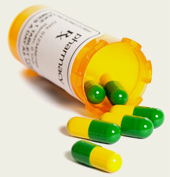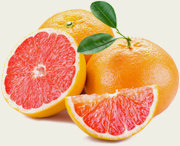Newsletters » Pharmaceutical Drug Contraindications

Pharmaceutical Drug Interactions or Contraindications
 For those who are taking pharmaceuticals, it is important to know how using natural "remedies" might interact or contradict their effect. I offer the following information in an effort to help you make an informed, responsible decision about whether or not to use essential oils alongside allopathic medications.
For those who are taking pharmaceuticals, it is important to know how using natural "remedies" might interact or contradict their effect. I offer the following information in an effort to help you make an informed, responsible decision about whether or not to use essential oils alongside allopathic medications.
Price writes in Aromatherapy for Health Professionals: "Essential oils are known to be active: they gain access to cells by virtue of being fat soluble and are metabolized by the body. As active agents they may react with other drugs present in the body, although there has been no evidence so far that would imply any significant adverse reaction, and essential oils have been used together with allopathic drugs successfully in hospitals." Price continues: "Until laboratory investigations into possible reactions between essential oils and other drugs have been carried out, it is possible only to surmise what may happen."1
David Stewart quotes from Dr. Jean Valnet: "[Valnet] mentions that 'some essences have been found to complement the action of antibiotics.' He gives Niaouli (Melaleuca quinquenervia) as an example of an oil that 'will increase the activity of streptomycin and penicillin.' Valnet also mentions that some oils containing aldehydes and ketones can 'inactivate antibiotics.' Other than these examples, Valnet does not discuss any other essential oil/drug interactions." Oils high in aldehydes (citral, citronellal cinnamic and decanal) include Cinnamon Bark, Lemongrass, May Chang, Melissa, Orange and Ginger. Oils high in ketones (menthone and camphor) include Peppermint, Rosemary, Sage and Spike Lavender.
Stewart continues: "The fact that Valnet only briefly mentions them while Pénoël and Friedmann, two other medical doctors, do not mention them at all in their books, suggests that adverse interactions between drugs and oils is not a serious problem - hardly worth mentioning."2
A "dose" of an essential oil, which is a combination of a number of components found in a whole plant, is far less than a single, concentrated dose of a single component found in pharmaceuticals. An essential oil provides a safer "dose" but may take longer to resolve the issue than a synthetic drug.3
Pharmaceuticals have side effects because the body does not recognize the molecular structure of a concentrated synthetic component,4 thus the body cannot metabolize it well and produces side effects. A whole plant product is easily assimilated by the body and rarely, if ever, produces negative side effects when used appropriately.5
All substances applied topically or taken internally must be metabolized (processed) by the body so that the individual cells can thrive. Metabolism and detoxification is a combination of both breaking down material and filtering out the toxic or unusable material. All that we eat, drink and apply to our skin including drugs, herbs and essential oils must go through this process. Detoxification mainly takes place in the liver, which removes the unusable or toxic substance from the blood, breaks it down and ushers it to the kidneys or intestines to be eliminated. The rate of detoxification determines how often a drug should be taken.
There are variables to this detoxification rate, and the rate can be affected by other substances the person eats or applies topically. Tisserand writes: "It is difficult to predict the probability of essential oil interactions with drugs, as a wide array of mechanisms could be involved . . . . Detailed information is scarce in most cases, but interactions with enzymes may be common. Some essential oil components [not the whole, but a single, isolated constituent] increase the production of certain metabolic enzymes. This action is referred to as enzyme induction. Induction of a particular enzyme may increase the rate at which a medication is metabolized and thereby decreases its blood levels and therapeutic actions. Inhibitors of drug metabolizing enzymes would have the opposite effect, causing blood levels to rise, and possibly increasing any side effects."6

Grapefruit?
Research shows that grapefruit juice blocks a special enzyme in the wall of the intestine that prevents many drugs from being absorbed into the body, making it easier for these medications to pass from the gut into the body, raising the blood levels of these drugs, which can create dangerous, toxic effects. So the question is asked, "What about the essential oil of Grapefruit?" You cannot equate the use of a whole herb or fruit with the use of an essential oil. Essential oils are only a small fraction of the whole plant. They are only the volatile aromatic molecules, which is typically less than 1% of the plant. Grapefruit juice is from the meat of the fruit, while essential oils are expressed or distilled from the rind. They are not one and the same.
I have no personal experience using essential oils with pharmaceuticals, but I do know of people who have found that they could use both and then wean themselves off of drugs that they have relied on for years. This territory has many variables, so the responsibility for how to go about using both and/or weaning off has to be with the user. I wish I could be of more help on this issue, but at this point, this is the extent of what I have to offer. Although there is very little research on actual drug interactions with essential oils, we are aware that some individual components of essential oils may slow down the process or potentiate it. The following information is noted by Tisserand to be "theoretical cautions." Also included are comments by David Stewart and Rhiannon Harris.
Acetaminophen (depletes glutathione)
Pennyroyal may exacerbate glutathione depletion.
Anesthesia
Many oils commonly used for respiratory issues, such as Rosemary, Eucalpytus, Ravintsara and Bay Laurel (Laurel Leaf) are high in 1,8 cineole, which can interfere with metabolism of anesthesia. Clinical aromatherapist, Rhiannon Harris notes that these should be avoided (both topically and via inhalation) for at least a week prior to any surgeries to prevent complications.7
Anticoagulant medication (such as Warfarin, Coumadin, aspirin or Heparin) or people with clotting or bleeding disorders, major surgery, childbirth, peptic ulcer or hemophilia
Eugenol found in Clove, Thyme ct. thymol and Oregano should be avoided orally.
Birch and Wintergreen should be avoided topically and orally.
Stewart addresses anticoagulant drugs: "Many practicing aromatherapists have thought that oils containing coumarins could be contraindicated when a person is taking anticoagulant drugs on the theory that coumarins are also anticoagulants and might cause too much thinning of the blood that could result in hemorrhages. However, coumarins in essential oils are not anticoagulants and pose no such hazards."
Stewart continues: "Wintergreen and birch oils might pose a risk of excessive blood thinning in combination with anticoagulant drugs, since they are both mainly composed of methyl salicylate, which has aspirin-like properties. However, such an occurrence would only be possible with large oral doses of these oils. They pose no such hazards when inhaled or applied to the skin in moderation."8
Antidepressants (MAOI or SSRI drugs such as Quinidine, Floxetine and Paroxetine, Codeine and Tamoxifen)
Topically or Orally
Clove (bud, leaf, stem) and Nutmeg should be avoided due to possible blood pressure changes, tremors or confusion. Also consider avoiding Holy Basil, Bay (West Indian), Cinnamon Leaf and Parsley Seed.
Essential oils containing farnesene and alpha-bisabolol such as Balsam Poplar, German Chamomile, Blue Tansy and Yarrow inhibit some metabolizing enzymes (CYP2D6) and may possibly potentiate the actions of some antidepressants.
(Also see the "Sedative" section below.)
Antidepressants such as Bupropion which inhibits CYP2B6 enzyme
Citral found in Lemongrass, May Chang, Honey Myrtle and Lemon Myrtle should be avoided as the oil may potentiate drug action. (Tisserand states that the risk is theoretical based on research.)
Anti-diabetic medication
Citral found in Lemongrass, May Chang, Honey Myrtle and Lemon Myrtle should not be taken orally.
Constituents of these oils may influence blood sugar levels: Anise, Star Anise, Cassia, Cinnamon Bark, Dill, Fennel (bitter and sweet), Geranium, Lemongrass, May Chang, Melissa, Myrtle, Lemon Myrtle, Oregano, Savory and Turmeric.
Aspirin sensitivity
Birch and Wintergreen contain methyl salicylate, which is the main component in aspirin. Some children with ADD/ADHD have salicylate sensitivity.
Constituents of these oils have some inhibiting properties for platelet aggregation and may exacerbate the blood-thinning action of these drugs: Anise, Star Anise, Cassia, Cinnamon Bark, Cinnamon Leaf, Clove (bud, stem, leaf) Cornmint, Fennel (bitter, sweet), Garlic, Lavandin, Marigold, Myrtle, Onion, Oregano, Patchouli, Ravensara Bark, Savory, Tarragon, Thyme ct borneol, Thyme ct limonene and Thyme ct thymol/carvacrol.
Calcium channel blocker (common in high blood pressure medication, felodipine was mentioned in the research)
Peppermint is a calcium channel blocker and may alter the effect as it may potentiate the medication when taken orally.
Diuretic medication
Anise has constituents with antidiuretic action.
Ephedrine (diet drug)
Eugenol found in Clove and Nutmeg should be avoided due to possible cardiovascular changes that may occur.
Liver and/or kidney impairment makes an individual more vulnerable to toxic effects of oil overuse.
Eugenol found in Clove, Thyme ct. thymol and West India Bay oil are prostaglandin inhibitors. Drug treatment for renal disease increases renal blood flow by mechanisms that are dependent on the effects of prostaglandins.
Sedatives (such as barbiturates, benzodiazepines, anesthetics)
Essential oils noted as "sedating" may interact when applied topically or taken internally. Harris notes that essential oils high in 1,8 cineole such as Rosemary, Eucalpytus, Ravintsara and Bay Laurel (Laurel Leaf) are contraindicated for those on barbiturates, as they induce rapid metabolism of these drugs.9
Transdermal drugs (skin patch)
Don't apply essential oils to the same area where the patch is located as they may speed up or slow down the delivery of the drug, thus altering the dose.
Many Blessings,
Linda and the HEO crew!
References
1 Price, Len; Price, Shirley (2011-11-11), Aromatherapy for Health Professionals, Elsevier Health Sciences UK, page 71.
2 Stewart, David Ph.D., D.N.M, The Chemistry of Essential Oils Made Simple, Care Publications, 2005, pages 395-396.
4 "Essential Oils Work in Harmony"
6 Tisserand, Robert; Young, Rodney, Essential Oil Safety: A Guide for Health Care Professionals, Elsevier Health Sciences UK 2nd Edition 2014, page 57-59.
7 Harris, Rhiannon. "Drug-Essential Oil Interactions: Risks and Reassurances," Presentation to Alliance of International Aromatherapists, (17 Dec. 2008), Denver, CO.
8 Stewart, David Ph.D., D.N.M, The Chemistry of Essential Oils Made Simple, Care Publications, 2005, pages 395-396.
9 Harris, Rhiannon. "Drug-Essential Oil Interactions: Risks and Reassurances,"
Presentation to Alliance of International Aromatherapists, (17 Dec. 2008), Denver, CO.



4 Newsletter Comments
Thanks Linda, for sharing this!
Sara
Wow!! Very interesting and informative. Thank you for posting.
Stacey
Very good info I will share. Thank you.
Jean
Thank You very much. Lots of useful info, to the point. Very Nice
Ken